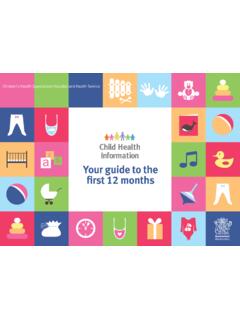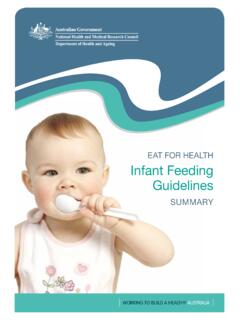Transcription of Guideline: Perinatal substance use: neonatal
1 Maternity and NeonatalClinical GuidelineQueensland Health Clinical Excellence Queensland Perinatal substance use: neonatal Queensland Clinical Guideline: Perinatal substance use: neonatal Refer to online version, destroy printed copies after use Page 2 of 33 Document title: Perinatal substance use: neonatal Publication date: September 2021 Document number: Document supplement: The document supplement is integral to and should be read in conjunction with this guideline. Amendments: Full version history is supplied in the document supplement. Amendment date: Full Review September 2021 Replaces document: Author: Queensland Clinical Guidelines Audience: Health professionals in Queensland public and private maternity and neonatal services Review date: September 2026 Endorsed by: Queensland Clinical Guidelines Steering Committee Statewide Maternity and neonatal Clinical Network (Queensland) Contact: Email: URL: Disclaimer This guideline is intended as a guide and provided for information purposes only.
2 The information has been prepared using a multidisciplinary approach with reference to the best information and evidence available at the time of preparation. No assurance is given that the information is entirely complete, current, or accurate in every respect. The guideline is not a substitute for clinical judgement, knowledge and expertise, or medical advice. Variation from the guideline, taking into account individual circumstances, may be appropriate. This guideline does not address all elements of standard practice and accepts that individual clinicians are responsible for: Providing care within the context of locally available resources, expertise, and scope of practice supporting consumer rights and informed decision making, including the right to decline intervention or ongoing management Advising consumers of their choices in an environment that is culturally appropriate and which enables comfortable and confidential discussion.
3 This includes the use of interpreter services where necessary Ensuring informed consent is obtained prior to delivering care Meeting all legislative requirements and professional standards Applying standard precautions, and additional precautions as necessary, when delivering care Documenting all care in accordance with mandatory and local requirements Queensland Health disclaims, to the maximum extent permitted by law, all responsibility and all liability (including without limitation, liability in negligence) for all expenses, losses, damages and costs incurred for any reason associated with the use of this guideline, including the materials within or referred to throughout this document being in any way inaccurate, out of context, incomplete or unavailable.
4 Recommended citation: Queensland Clinical Guidelines. Perinatal substance use: neonatal . Guideline No. 26. Queensland Health. 2021. Available from: State of Queensland (Queensland Health) 2021 This work is licensed under a Creative Commons Attribution-NonCommercial-NoDerivatives International licence. In essence, you are free to copy and communicate the work in its current form for non-commercial purposes, as long as you attribute Queensland Clinical Guidelines, Queensland Health and abide by the licence terms. You may not alter or adapt the work in any way. To view a copy of this licence, visit For further information, contact Queensland Clinical Guidelines, RBWH Post Office, Herston Qld 4029, email For permissions beyond the scope of this licence, contact: Intellectual Property Officer, Queensland Health, GPO Box 48, Brisbane Qld 4001, email Cultural acknowledgement We acknowledge the Traditional Custodians of the land on which we work and pay our respect to the Aboriginal and Torres Strait Islander Elders past, present and emerging.
5 Queensland Clinical Guideline: Perinatal substance use: neonatal Refer to online version, destroy printed copies after use Page 3 of 33 Flow Chart: Management of neonatal abstinence syndrome Queensland Clinical Guideline: Perinatal substance use: neonatal Perform clinical assessment Review maternal/newborn history Review risk factors for sepsis Discuss possible undisclosed substance use with woman Perform clinical examination Consider differential diagnoses Treat identified illnessCriteria for pharmacological treatment met?Admit to neonatal unit Commence pharmacotherapy Titrate to control signs of NAS Continue formal assessment Continue supportive carePrepare for dischargeDischarge criteria Baby clinically well, feeding, weight loss not more than 10% of BW Appropriate family/carer identified Home environment safe Recommended LOS reviewed Review and confirm Multidisciplinary discharge plan Parent education completed Immunisations Community referrals Follow up appointments Child safety plan and notificationsIf home medication Education complete Storage/safety addressed Support and follow-up confirmed FNAS: every 4 6 hours within 30 minutes after feeds OR ESC.
6 After feeds every 3 4 hours substance isopioid, unknown or polysubstances?Close observation Routine newborn observationso Increase frequency as indicated Maintain awareness for signs of NAS Signs of NAS?Baby at risk of NASYesNoYesSupportive care for all babiesDo not administer naloxone during resuscitation or newborn period Rooming-in Skin-to-skin Encourage breastfeeding Minimise hunger Small frequent feeds Reduce noise and light Protect sleep and cluster cares Swaddle and nest Respond early to baby cues Swaying and rockingNoNoFormal assessmentcommence within 2 hours of birthBW: birth weight, ESC: eat, sleep, console protocol, FNAS: Finnegan neonatal abstinence score, LOS: length of stay, NAS: neonatal abstinence syndrome Queensland Clinical Guideline: Perinatal substance use: neonatal Refer to online version, destroy printed copies after use Page 4 of 33 Table of Contents Abbreviations.
7 5 Definitions .. 5 1 Introduction .. 6 Incidence in 6 Modulating factors .. 6 Clinical standards .. 7 2 Initial newborn care .. 8 Clinical surveillance .. 8 3 Assessment .. 9 Signs NAS .. 9 Clinical assessment .. 10 Differential diagnosis .. 10 Assessment tools .. 11 Finnegan neonatal abstinence severity score .. 11 Eat, sleep, console .. 12 Specific substances and NAS .. 13 4 Supportive care .. 14 Feeding .. 15 Optimal feeding .. 15 breastfeeding .. 15 5 Pharmacological therapy .. 16 Morphine hydrochloride schedule .. 17 Phenobarbital 18 6 Discharge planning .. 19 Home medications .. 19 Discharge criteria .. 20 Timing of discharge .. 20 Follow up and support.
8 21 References .. 22 Appendix A: Finnegan neonatal Abstinence Severity Score .. 25 Appendix B: Finnegan neonatal Abstinence Severity Score Description .. 26 Appendix C: Eat, Sleep Console assessment .. 27 Appendix D: Eat, Sleep Console descriptions .. 28 Appendix E: Supportive care .. 29 Appendix F: Communicating with and comforting baby .. 30 Appendix G: Baby stability and stress signals .. 31 Appendix H: breastfeeding recommendations by substance .. 32 Acknowledgements .. 33 List of Tables Table 1. Modulating factors for NAS .. 6 Table 2. Clinical standards .. 7 Table 3. Newborn care .. 8 Table 4. Clinical surveillance .. 8 Table 5. Signs of NAS .. 9 Table 6. Clinical assessment .. 10 Table 7. Differential diagnosis.
9 10 Table 8. Finnegan neonatal abstinence severity score .. 11 Table 9. Eat, sleep, console .. 12 Table 10. Specific substances and NAS .. 13 Table 11. Non-pharmacological supportive care .. 14 Table 12. Optimal feeding .. 15 Table 13. breastfeeding .. 15 Table 14. Pharmacological management .. 16 Table 15. Morphine hydrochloride schedule .. 17 Table 16. Phenobarbital dosing and weaning schedule .. 18 Table 17. Discharge preparation .. 19 Table 18. Home medications .. 19 Table 19. Discharge criteria .. 20 Table 20. Timing of discharge .. 20 Table 21. Follow up .. 21 Queensland Clinical Guideline: Perinatal substance use: neonatal Refer to online version, destroy printed copies after use Page 5 of 33 Abbreviations CNS Central nervous system GI Gastrointestinal GP General practitioner IV Intravenous NAS neonatal abstinence syndrome NP Nurse practitioner SIDS Sudden Infant Death Syndrome SNRI Serotonin noradrenaline reuptake inhibitors SSRI Selective serotonin reuptake inhibitors SUDI Sudden Unexplained Death of an Infant Definitions Multidisciplinary team Membership is influenced by the needs of the parent/carer, the baby, availability of staff, and other local resourcing issues.
10 May include a range of multidisciplinary professionals including, but not limited to, nurse/midwife, obstetrician, neonatologist/paediatrician, nurse practitioner, pharmacist, lactation consultant, other specialist practitioners ( maternal fetal medicine specialist), general practitioner, social worker/counsellor and allied health workers from hospital and community services including government and non-government organisations. Full team review Within the Eat, Sleep Console method of assessment, includes as a minimum the parent/carer, main staff care providers (nurse or midwife, team leader), and medical officer or neonatal nurse practitioner. Other members of the multidisciplinary team ( pharmacist) may be included as required.













